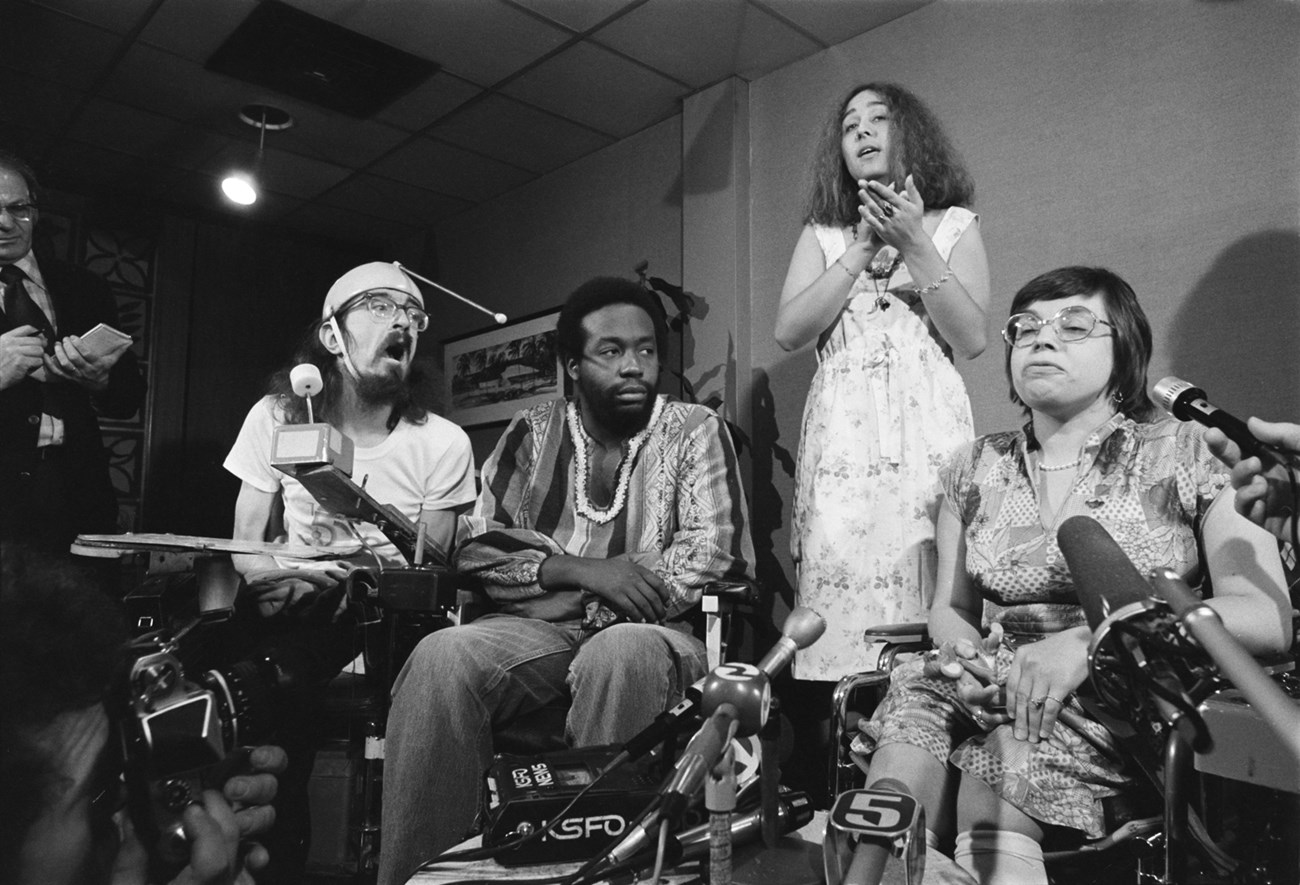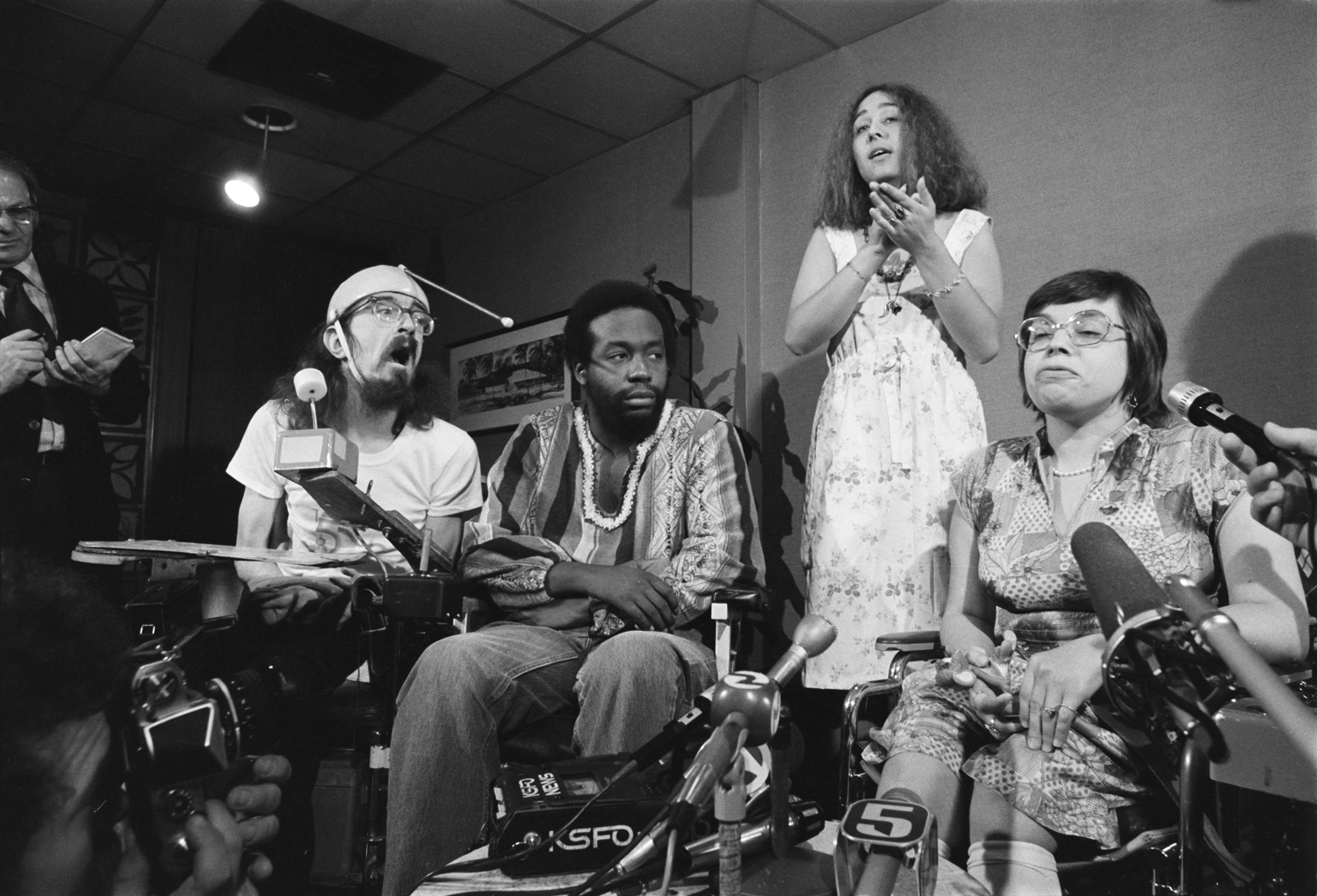
From left: Hale Zukas, Ron Washington and Judy Heumann answer questions during a press conference at San Francisco airport before the protesters departed for Washington. Lynette Taylor serves as an American Sign Language interpreter.
San Francisco Examiner Archives, courtesy of the Bancroft Library, University of California, Berkeley.
When have you benefited from the support of others? By working together, you were able to accomplish more than you could have achieved on your own?
In April 1977, a group of about 100 people with various disabilities staged a month-long sit-in as part of a nationwide protest. The protesters demanded that the federal government respect their civil rights. They felt they had waited too long for the access that was legally allowed. They didn’t just want access to buildings and structures; they wanted to participate in programs and activities that non-disabled people could enjoy. The goal of their protest was to force the federal government to enforce Section 504 of the Rehabilitation Act of 1973. Often referred to as 504, this act was the first federal law to recognize disability as a civil rights category. [1].
Section 504 of the Rehabilitation Act of 1973 is less than 100 words long and reads as follows:
“An otherwise qualified individual in the United States with a disability, as defined in section 705 of the Code, shall not, on the sole basis of disability, be denied participation in, denied the benefits of, or subjected to discrimination under any program or activity receiving Federal financial assistance.”
How did we get here?
The purpose of the Rehabilitation Act of 1973 was twofold: First, it required affirmative action measures for the employment of people with disabilities by both the federal government and its contractors. [2]Second, it prohibited discrimination on the basis of disability. This law applied to all programs that received federal funds, and in 1978 it was expanded to all programs run by federal agencies. Section 504 addressed basic needs that people with disabilities had: access to education and employment. In other words, Section 504 extended civil rights to people with disabilities. Problems arose because the regulations for this section had not yet been published. Federal law stated that “reasonable accommodations” had to be made for people with disabilities, but there was no way to verify or enforce them.
Without regulations, accessibility features were unavailable to both disabled and non-disabled people. Today, these amenities include curb cuts, handrails, and ramps in federal buildings, and access to public schools. They also required alternative language options such as Braille and American Sign Language. Lack of accessibility not only separated disabled people from the general public, but also from each other. Disabled people had a very clear idea of what they needed. But according to John Wodach, a civil rights lawyer at HEW in the 1970s, there was very little cross-disability organizing (504 at Fifty, with John Wodach, Part 1).
Regulations were developed during President Ford’s administration but were not published by the time the president left office. There was significant resistance to the publication of the regulations from the organizations that needed to comply with the new requirements of 504. These organizations, such as schools and hospitals, did not want to incur the costs required to comply with the 504 regulations. After years of delay, the task of approving the publication of these regulations fell to President Carter’s Secretary of Health, Education and Welfare, Joseph A. Califano, Jr.
“Sign 504!” Protests begin
In 1977, Americans with disabilities waited four years for the Section 504 regulations to be signed. By April of that year, they had had enough. The American Council on Disabilities (ACCD) was preparing to put pressure on HEW Director Joseph A. Califano. ACCD leaders had evidence that Califano was working with lobbyists to weaken the Section 504 regulations. To counter this, they gave Califano an ultimatum: either approve the publication of the Section 504 regulations unrevised by April or resign. When neither demand was met, disability groups began to develop a new strategy. On April 5, 1977, ten protests were launched across the United States. On the first day, protests took place outside HEW offices in San Francisco (California), Washington DC, Seattle (Washington), Los Angeles (California), Denver (Colorado), Chicago (Illinois), Dallas (Texas), Atlanta (Georgia), New York City (New York), Boston (Massachusetts) and Philadelphia (Pennsylvania).
After spending several hours outside, organizers led the protesters back inside the HEW building. Sit-ins occurred all across the country, housing people with all kinds of disabilities, from wheelchair users to the hearing and blind. These protests took place in all 10 cities, but only the sit-in at 50 UN Plaza in San Francisco lasted beyond the first few days. [3]Protesters occupied the HEW offices for the next 26 days.
Stronger Together
Committees were formed within the office to continue the protests. They had to arrange for food, sanitation, medical needs, and publicity. Some of the committee members were people who had been involved in protest organization. People like Judy Heumann had been involved in protest organization for years at this point. She became politically active for disability rights after suing New York State to become the first person with a disability to receive a teaching license. Within the HEW office, she took on the important task of making sure the basic needs of the protesters were met.
Other leaders were participants at first, but assumed leadership roles once inside the building. Kitty Cone became a key logistical organizer. Another protester, Dennis Billups, helped motivate the protesters. He joined the protest at the urging of his sister, who also has a disability. Once the sit-ins began, Billups became heavily involved in motivating the protesters and mediating conflicts. He also became a member of the Black Panther Party during the sit-ins.
Protesters inside the HEW office relied on each other and their support networks to stay as healthy as possible. They went without medical equipment and personal aids that help them in their daily lives. People slept on the floor and had no access to kitchen facilities. Kitty Kohn created a makeshift “fridge” out of office supplies. They placed boxes around the air conditioning unit to keep vital medicines cool.
Some people with impaired mobility were unable to move on their own, which meant that lying on the floor in the same position all night put them at risk of developing bed sores. The only way to prevent bed sores was to get help from others. After a few days, the police cut off the hot water and the phone lines. With no means of audio communication, the protesters turned to people who could sign. Someone inside the building would sign through the window to let supporters outside know what was happening inside the building.
The protests had supporters beyond the disability community; many other organizations, including the Brick Hat Lesbian Cooperative and Glide Memorial Church, also helped ensure protesters’ basic needs were met. This broad support was key to the success of the San Francisco sit-ins. Another important ally of the protests was the International Association of Machinists (IAM), a labor union that has been involved in the civil rights movement for decades.
Many of the protesters were active in other civil rights movements. These connections helped them build a broader network of support. Some of them were members of the Black Panther Party and suggested that protest organizers reach out to them for help. Local chapters of the Black Panther Party provided food and other supplies to the protesters. They delivered one hot meal each day, plus enough supplies for two more meals. Some protesters went even further and staged hunger strikes. They said they would not eat until 504 was signed or Joseph Califano resigned.
This protest to get the 504 ordinance signed was one of the few times that such diverse people with disabilities came together for such a long period of time. Lack of accessibility often kept people with disabilities isolated from each other. Only in rare cases, such as special camps, could they come together as a larger group. The 26 days at 50 UN Plaza created an opportunity for solidarity between the various disability communities. Protesters came together to share stories of struggles and triumphs in life. Not everyone can empathize with all the experiences of others, but they believed each other’s stories. The bonds forged between people with different disabilities during the 504 protest in 1977 have contributed to building the disability community today.
On to Washington DC and to victory!
A few weeks after the sit-ins began, a delegation of protesters, including Judy Heuman and Dennis Billups, traveled to Washington DC. IAM paid for the travel expenses of this small delegation. The protesters wanted to meet with President Jimmy Carter and pressure him about 504. Upon arriving in DC, the protesters ran into a problem: they couldn’t find transportation to accommodate the wheelchair users. To get around DC, IAM rented a box truck, which can carry about a dozen wheelchair users at a time. Because the protesters had no funds, they needed to get things done in the least expensive way possible, even if that meant traveling around the city in the dark, confined to the back of a truck.
Despite the protesters’ relentless efforts, neither Carter nor Califano would meet with any of them. They did meet with one of President Carter’s staff, but this action did not increase pressure on Califano. At this time, news of the sit-in at 50 UN Plaza in San Francisco was reported nationwide, and tactics in Washington became more aggressive. Now reporters were there, broadcasting to the American people. People watched as the president sneaked out the back door to avoid the protesters. Under increasing pressure from the media, Joseph Califano signed the regulations of Section 504 of the Rehabilitation Act of 1973. Eventually, the protesters left 50 UN Plaza to make America a better place for people with disabilities.
“In the face of our government’s ignorance, inhumanity, deceit, and closed doors, we have persevered. With all of our amazing supporters, we have won. I swear to God, no one gave us anything!” – Kitty Kohn, protest organizer, “Sit-in Victory Speech”
Twenty-six days after entering the building, protesters left 50 UN Plaza. They were greeted by friends, loved ones, and the media. This was a major victory for the U.S. disability community. It shows that collectively, people with disabilities are powerful. They are willing and able to stand up for themselves and fight for disability rights in America.
Consider: Footnotes:
1: The Architectural Barriers Act was passed in 1968. This act mandated access to federal facilities, including restrooms, which some argue is a civil right. The Architectural Barriers Act was the first civil rights law regarding disabilities. However, the Rehabilitation Act of 1973 explicitly classified disabilities as a civil rights category. Section 504 mirrored the language of the 1964 Civil Rights Act.
2: The language used to talk about people with disabilities is changing. Some people prefer person-centered language, such as “disabled.” Others prefer identity-centered language, such as “handicapped.” To reflect this changing language, both phrases are used in this article.
3: The Federal Building was separately listed on the National Register of Historic Places on June 5, 2017.

